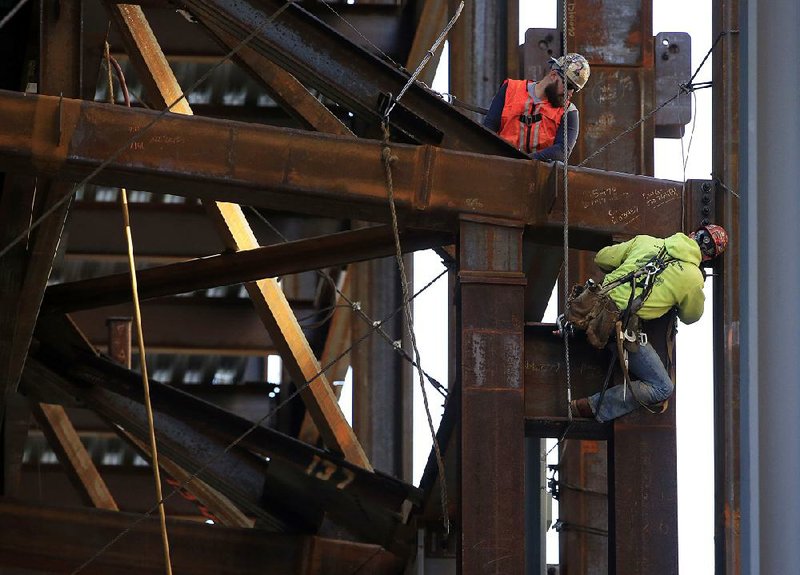WASHINGTON -- The economy in the U.S. expanded at a slower pace in the third quarter as companies took advantage of gains in consumer and business spending to reduce bloated stockpiles.
Most economists think growth has been strengthening since the July-September quarter ended.
The Commerce Department said Thursday that the economy, as measured by the gross domestic product, grew at a tepid annual rate of 1.5 percent in the July-September quarter, far below the 3.9 percent rate of the previous quarter.
The biggest reason was a push by businesses to shrink unwanted stockpiles, which cut 1.4 percentage points from quarterly growth but is expected to be only temporary. Encouragingly for the economy, consumer spending remained solid over the summer: It rose at a 3.2 percent annual rate, down only slightly from the previous quarter.
"The story on inventories is that it's a big adjustment that occurred quickly and should be far less of a drag" in the next few quarters, Stuart Hoffman, chief economist at PNC Financial Services Group Inc. in Pittsburgh, said before the report.
Most analysts have said they think businesses are stepping up their stockpiling this quarter in response to the continued gains in consumer spending. Many predict that growth in the October-December quarter will rebound to around a 2.5 percent annual rate.
"The headline is not indicative of how solidly the U.S. is growing," said Gennadiy Goldberg, U.S. rates strategist in New York with TD Securities. "The domestic drivers in consumption are quite strong."
Ian Shepherdson, chief economist at Pantheon Macroeconomics, said that excluding the drag from scaled-back inventory rebuilding, Thursday's report was "solid." Noting the consistent strength in consumer spending, Shepherdson said he thinks the current quarter's annual growth rate could reach 3 percent.
For all of 2015, the economy is expected to expand around 2.3 percent, near last year's modest 2.4 percent, despite persistent economic weakness around the world.
Still, last quarter's slump marked the latest slide for an economy that began 2015 on a rocky note as a severe winter and West Coast port disruptions essentially stalled growth. The economy rebounded in the April-June quarter before weakening again in the summer. The report Thursday was the government's first of three estimates of growth for the third quarter.
Last quarter, in addition to the drag from reduced inventory rebuilding, a wider trade deficit also held back growth. That weakness is likely continuing as manufacturers struggle with slowdowns in key export markets such as China. A stronger dollar has also hurt sales by making American products less competitive overseas.
Business investment spending grew by a modest 2.1 percent in the third quarter, just half the second-quarter rate. Investment in structures fell at a 4 percent rate. That decline reflected a 47 percent plunge in investment in a category that includes oil and gas drilling, which has suffered huge cutbacks with the drop in global energy prices.
Government spending grew at a moderate 1.7 percent annual rate, slower than the 2.6 percent pace in the second quarter. It reflected a smaller gain in state and local spending.
The 3.2 percent annual rise in consumer spending in the third quarter was only slightly below the 3.6 percent growth rate in the second quarter. Sales of durable goods such as autos led the way.
Consumer spending drives about 70 percent of economic activity, and most economists think that support will continue because of steady job gains. The unemployment rate was at a seven-year low of 5.1 percent in September, though the pace of hiring weakened over the past two months.
Wages have yet to rise significantly for most people, but more jobs have meant more people have money to spend.
Most economists expect hiring to pick up in the final stretch of the year and make consumers more likely to spend during the Christmas shopping season. A renewed decline in energy prices is also giving consumers more money to spend on other goods and services.
Applications for unemployment benefits in the U.S. were little changed last week, hovering close to four-decade lows and showing steady progress in the labor market.
Unemployment claims increased by 1,000 to 260,000 in the week ended Oct. 24, a Labor Department report showed Thursday. The four-week average of applications dropped to the lowest level since December 1973, while the number of Americans on benefit rolls shrank.
Tight demand for labor is encouraging employers to retain workers even as slower sales to overseas customers cause some companies to slow the pace of hiring. Federal Reserve policymakers said Wednesday that while job growth has recently cooled, excess slack in the labor market is gradually shrinking, leaving open the possibility of an interest-rate increase as soon as December.
"Job destruction is really not that big of an issue," Scott Brown, chief economist at Raymond James Financial Inc. in St. Petersburg, Fla., said before the report. "The claims numbers have been trending incredibly low."
Information for this article was contributed by Martin Crutsinger of The Associate Press and Michelle Jamrisko, Chris Middleton and Victoria Stilwell of Bloomberg News.
Business on 10/30/2015

